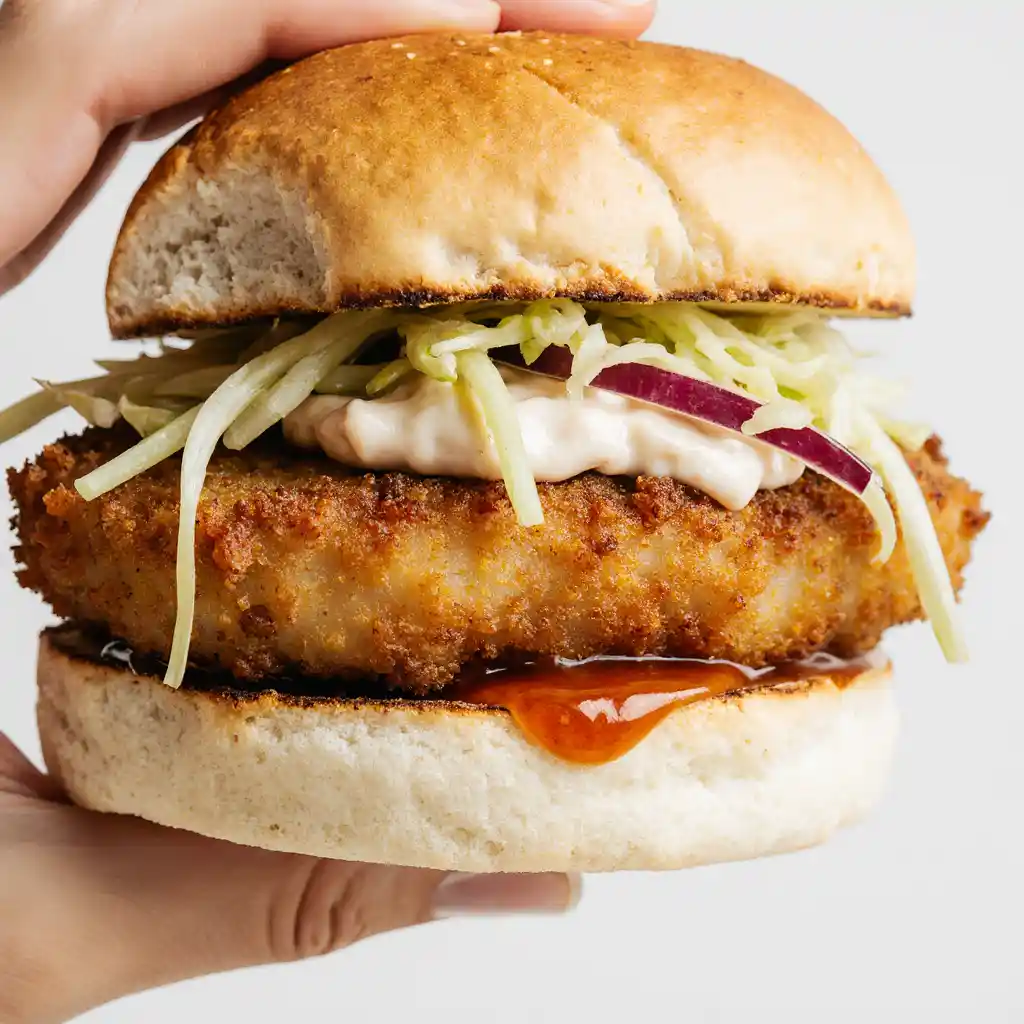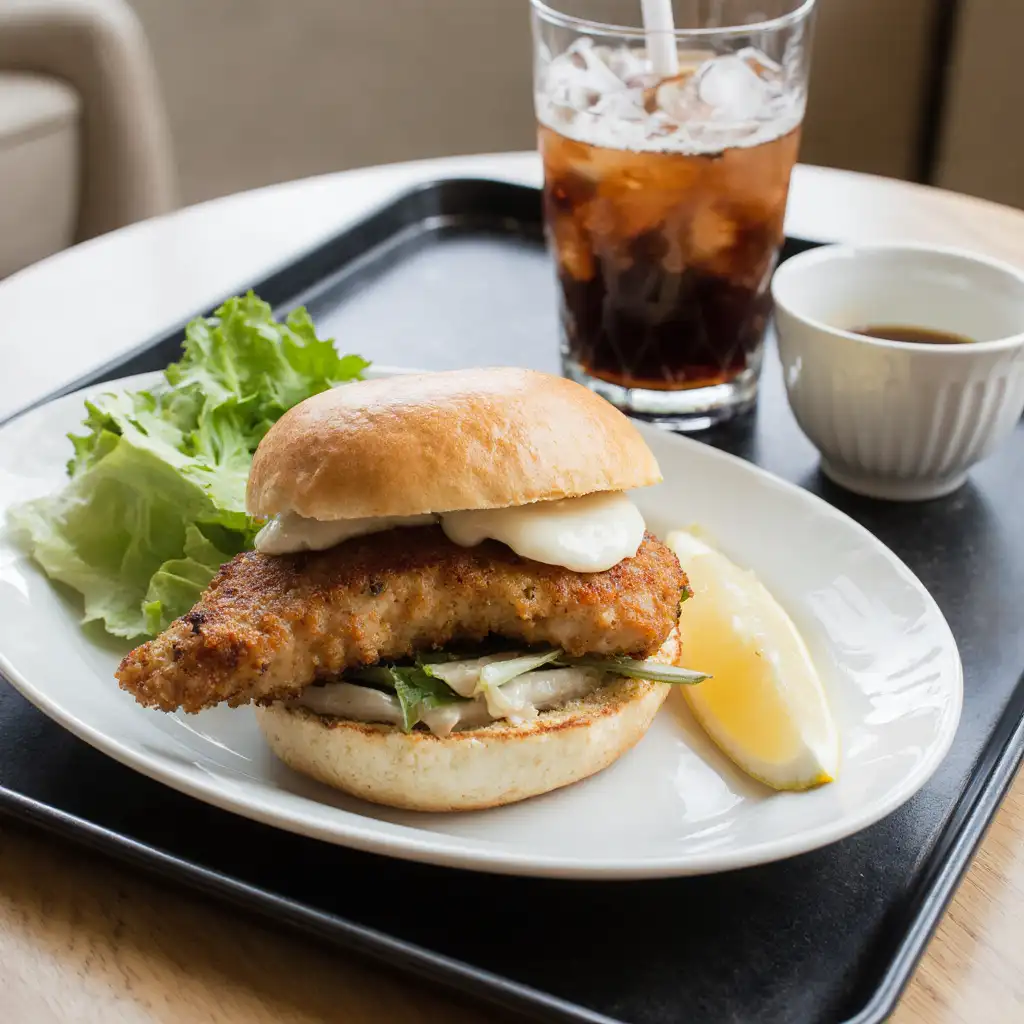Confession: I still remember the first time chicken katsu sando caught my eye on a friend’s Instagram feed. Crisp, golden breading was bursting from pristinely sliced, snowy white shokupan. The entire sandwich glistened with a pop of pink kimchi and neon aioli.
When I finally tasted it at a cozy pop-up café in LA, it was love at first bite. The chicken was incredibly juicy, the crust stayed impossibly crispy, and the tangy slaw and zingy sauces made every mouthful both comforting and daringly modern.
Lately, chicken katsu sando has exploded onto social feeds and in real life, popping up in New York, London, and foodie enclaves worldwide.
Today, let’s unlock all the secrets to making a trendy, café-style chicken katsu sando—plus all the fusion upgrades the new global generation loves. We’ll cover step-by-step techniques, origins, nutrition swaps, restaurant picks, FAQs, and more.
What is Chicken Katsu Sando?
Classic Origin: What Does カツサンド (Katsu Sando) Mean?
Chicken katsu sando is a beloved Japanese sandwich featuring a tender breaded chicken cutlet encased in fluffy, subtly sweet shokupan (Japanese milk bread). The term “katsu” is short for “katsuretsu,” meaning cutlet, and “sando” is the Japanese abbreviation for sandwich. It was born in Japanese cafés and convenience stores as an homage to Western sandwiches but took on a distinct local identity. Over time, katsu sando became a cult food in Tokyo a favorite for lunchboxes, quick bites, and even high-end restaurant tasting menus. Beyond Tokyo, it’s now riding a wave of popularity in American cafés, fusion restaurants, and global foodie markets.

Chicken Katsu Sando (Cafe-Style, Trending 2025)
Equipment
- mixing bowls
- meat mallet or rolling pin
- Tongs
- frying pan or deep skillet
- Wire rack
- sharp knife
Ingredients
- 2 boneless skinless chicken thighs (or breasts)
- 1 tbsp soy sauce
- 1 tsp grated ginger
- 1/2 tsp black pepper
- 1/2 cup all-purpose flour
- 1 egg, beaten
- 1 cup panko breadcrumbs
- 1 cup neutral oil (canola or sunflower) for frying
- 1 cup shredded cabbage or kimchi slaw
- 4 slices shokupan (Japanese milk bread) or brioche
- 2 tbsp Kewpie mayo or sriracha mayo
- 2 tbsp tonkatsu sauce (or BBQ/Sriracha blend)
- 1 tsp rice vinegar (for slaw)
- 1 tbsp kimchi juice (optional, for fusion flavor)
- 1 lime wedge or microgreens, for garnish
Instructions
- Pound chicken thighs to ½-inch thickness and marinate with soy sauce, grated ginger, and black pepper for 20–30 minutes.
- Prepare three bowls for dredging: flour, beaten egg, and panko. Coat chicken in flour, then egg, then press firmly into panko.
- Heat oil to 340°F (170°C) and fry chicken 2–3 minutes per side until golden. Drain on a rack, then raise heat to 375°F (190°C) and fry again 1 minute per side for extra crunch.
- Make slaw: combine shredded cabbage with rice vinegar and a pinch of salt, or toss kimchi with lime and sugar for a fusion version.
- Spread mayo on bread slices, layer slaw, place the fried chicken cutlet, and drizzle with tonkatsu or spicy sauce. Top with remaining bread slice.
- Cut diagonally for presentation and serve immediately while hot and crispy. Garnish with microgreens or a lime wedge.
Notes
From Tokyo to LA: The Evolution of the Fusion Chicken Sandwich
Traditionally, katsu sando was a simple construction: a deep-fried pork (tonkatsu) or chicken cutlet, crisp cabbage, and a sweet-savory tonkatsu sauce tucked inside shokupan. While these roots remain, today’s global chicken katsu sando goes far beyond. In LA, New York, London, and Sydney, modern chefs layer on kimchi slaw, spicy mayo, and even additional pickles or microgreens. Many US cafés double-fry their chicken for extra crunch, swap in gluten-free panko, or finish with house-fermented sauces. The result is a sandwich that fuses Japanese comfort food with western sandwich culture and a distinctly photo-friendly, flavor-forward spin fit for the world’s most creative cafés.
Chicken Katsu Sando Ingredients & Substitutions
To make a standout chicken katsu sando, high-quality ingredients and strategic substitutions are everything. This section dives into essential staples, innovative swaps, and sourcing secrets so you can perfect both the classic and fusion versions at home.
| Ingredient | Classic | Fusion/US Substitution | Notes |
|---|---|---|---|
| Chicken breast/thigh | Yes | Tofu, seitan | Thigh offers more flavor and juiciness; breast yields a milder bite |
| Shokupan | Yes | Brioche, Pullman, Texas toast | Look for pillowy, enriched loaves: shokupan is best but these US alternatives are close |
| Panko breadcrumbs | Yes | Gluten-free panko, classic breadcrumbs (in a pinch) | Panko delivers maximum crunch never skip if possible! |
| Kimchi slaw | No | Red cabbage-carrot slaw, radish, pickled onion | Kimchi juice adds vibrant color and tang trendy and probiotic-rich |
| Kewpie mayo | Yes | Lemon aioli, sriracha mayo, Greek yogurt-based options | Japanese mayo’s richness is hard to beat, but fusion sauces keep it modern |
| Tonkatsu sauce | Yes | BBQ sauce, sriracha-ketchup, Korean gochujang glaze | Classic tangy-sweet flavor or experiment with spicy and smoky blends |
| Wasabi, shichimi | Optional | Pickled jalapeños, hot sauce, black pepper | For a “kick” and an authentic or Americanized finish |
- Where to Buy: Check Asian supermarkets or Japanese bakeries for shokupan and Kewpie mayo. Many mainstream groceries now stock Japanese mayo and panko and you can always find shokupan substitutes at a good bakery.
- Healthy Options: Air-fry your chicken, swap in Greek yogurt for mayo, or choose gluten-free and whole grain panko. Some modern cafés even offer plant-based katsu using tofu or seitan, following the trend toward wellness and sustainability.
- Allergen Info and Tips: Double-check your panko and sauce ingredients if cooking for gluten-sensitive or egg-free eaters. Shokupan sometimes contains milk powder; Pullman and certain brioche loaves are dairy-free if needed.
How to Make Chicken Katsu Sando (Pro Method + Modern Fusion)
Master the ultimate chicken katsu sando at home with these step-by-step techniques that blend Japanese tradition and international café flair. Each detail is crafted for crispiness, flavor layering, and viral food appeal.

1. Ingredient Prep: Choosing and Marinating Chicken
Start with boneless, skinless chicken thighs for classic Japanese juiciness, or breasts for a lighter, leaner bite. Pound the meat to a uniform ½-inch thickness for even frying and maximum surface crunch. Marinate in 1 tbsp soy sauce, 1 tsp grated ginger, and black pepper for 20–30 minutes. This infuses flavor and sets the stage for that classic katsu aroma. For a plant-based twist, press extra-firm tofu or slice seitan cutlets, marinate as above.
2. Breading and Double Frying Keys to Ultimate Crunch
- Line up three shallow bowls: flour, beaten egg, and panko. Dredge the chicken first in flour (shake off excess), then egg, then press into panko until totally coated.
- For gluten-free: Use certified gluten-free panko or cornflake crumbs for a similar effect.
- Fry in 1 inch of neutral oil (canola, sunflower, or light olive) at 340°F (170°C) until golden, about 2–3 min per side. Drain on a rack for 2–4 min.
- Raise heat to 375°F (190°C) and fry again 1 min per side; this double-fry guarantees lasting crunch even after saucing. Air fryer alternative: 400°F, ~10 12 min, flipping halfway.
3. Making Slaw: Classic Cabbage & Bold Kimchi Fusion
- Classic Slaw: Finely shred green cabbage, toss with a pinch of salt and 1 tsp rice vinegar, rest 10 min, then squeeze out excess liquid.
- Kimchi Slaw: Combine 1 cup thinly sliced napa cabbage, 2 tbsp kimchi juice, ¼ cup chopped kimchi, a splash of lime, and a pinch of sugar for balance. The kimchi’s tang cuts through the richness of the fried chicken, adding probiotics and zing.
- Global Variations: Toss in rainbow carrots, scallions, or pickled daikon for extra color and crunch. Some LA cafés even add microgreens or shaved fennel for freshness and drama.
4. Building Café-Perfect Chicken Katsu Sando: Assembly Tips
- Spread a generous layer of Kewpie mayo (or sriracha mayo for heat) on both bread slices to create a moisture barrier.
- Heap a thick layer of your chosen slaw on the bottom slice cabbage for crunch, kimchi for color and tang, or both for fusion flavor.
- Place the hot, double-fried chicken cutlet atop the slaw. Drizzle with classic tonkatsu sauce or, for a modern twist, spicy mayo, wasabi aioli, or even a chili crisp glaze. Layer extra sauce on top bread if desired.
- Press the sandwich gently, then cut firmly on the diagonal with a sharp serrated knife. This not only makes it Instagram-friendly but also reveals every vibrant layer in cross-section.
- Serve immediately to preserve maximum crispness. If packing for lunch, keep slaw on the side until ready to eat.

For food styling, some trend-forward US cafés dust the finished sando with togarashi, add a sprig of fresh herbs, or sandwich everything between mini shokupan rolls for sliders perfect for parties.
5. Expert Storage, Make-Ahead, & Serving Tips
- Chicken katsu keeps its crunch best if stored unassembled (on a rack, uncovered, up to 1 hour), then assembled just before serving.
- Leftover cutlets can be reheated in a 400°F oven or air fryer for 5–8 minutes.
- Slaw is best made day-of, but can be prepped a few hours in advance (drain excess juice before assembly).
- Cut sandwiches hold beautifully for lunchboxes if gently wrapped in parchment foil just add slaw in a separate container.
Trending Sauces & Flavor Twists
- Tonkatsu Sauce Revival: Mix 2 tbsp ketchup, 1 tbsp Worcestershire sauce, 1 tbsp soy, 1 tsp sugar. Add a splash of rice vinegar for extra tang. Don’t skip the umami-rich hit of Worcestershire; it’s essential for depth.
- Spicy Mayo: Combine 4 tbsp Kewpie mayo with 1 tbsp Sriracha or Korean gochujang. Bright, creamy, and with adjustable heat.
- Wasabi Aioli: Mash 1–2 tsp wasabi paste into 3–4 tbsp mayo (or Greek yogurt), plus a squeeze of lemon for acidity.
- Miso-Honey Butter: For an American-Japanese brunch twist, blend 1 tbsp softened butter with ½ tbsp miso and ½ tbsp honey. Spread on toasted bread or use as a finishing drizzle.
- Chili Crisp Upgrade: Trending in NYC and LA, chili crisp (like Lao Gan Ma) adds crunch, smoke, and mild heat drizzle sparingly for visual and textural drama.
| Sauce | Base Ingredient | Add-Ins | Best Paired With |
|---|---|---|---|
| Tonkatsu | Ketchup | Soy, Worcestershire, sugar | Classic sando, cabbage slaw |
| Spicy Mayo | Kewpie mayo | Sriracha, gochujang | Kimchi or fusion slaw |
| Wasabi Aioli | Mayo or yogurt | Wasabi, lemon juice | Slaw, pickles, extra greens |
| Miso-Honey Butter | Butter | Miso, honey | Brioche or Texas toast versions |
Experiment with drizzling or serving sauces on the side to let everyone customize their own flavor adventure. Some US cafés even offer house sauce “flights” for serious sando fans!
Chicken Katsu Sando Nutrition, Calorie, and Health Guide
Chicken katsu sando may be indulgent, but it’s surprisingly versatile for health-minded eaters. Here’s a look at classic calories, how to lighten it up, plus nutrition science for every modification.
- Classic (fried, with Kewpie and slaw): About 600 calories, 28–32g protein, 21–28g fat depending on the thickness of bread and details of sauce/slaw.
- Oven-baked/Air-fried Version: About 390–420 calories per sandwich. Air-frying slashes oil absorption, while still delivering crunch.
- Gluten-free: Using gluten-free panko reduces carbs slightly; paired with gluten-free bread, it’s accessible for celiacs.
- Plant-based/vegan: With seitan or tofu “cutlets,” use egg replacer and plant-based milk for batter; vegan mayo and sauce complete the picture. Macros shift to ~270–320 cal/sando, 13–18g protein.
| Method | Calories (avg) | Texture | Tips |
|---|---|---|---|
| Fried | 600 | Ultra-crispy, juicy | Don’t overcrowd pan; rest on rack |
| Oven-baked | 390 | Very crisp, less oil | Spray panko with oil; use convection if possible |
| Vegan/Seitan | 320 | Crispy outside, chewy center | Extra seasoning for depth; vegan mayo |
Where to Try & Trending Cafes (Global Sando Scene)
Chicken katsu sando isn’t just a recipe it’s a movement. Here are some of the world’s top spots for experiencing it, plus what makes their version a must-try:
- Cafe Okawari (LA): Renowned for double-thick cutlets, tangy kimchi slaw, and pillowy house-made shokupan often sells out by noon!
- Konbi (LA): The sandwich that started a viral trend stateside, celebrated for its super-crisp panko exterior and secret sauce blend.
- Century Shokupan (LA): Hand-baked traditional bread and rotating seasonal slaws (try the yuzu-dressed cabbage, or winter apple-ginger slaw).
- Hi-Collar (NYC): Combines classic Japanese technique with New York bravado; serves pork and chicken katsu daily, with sake pairings.
- Maisen (Tokyo): A gold standard for classic katsu sando, perfect pork or chicken on ethereal bread the Tokyo original, often copied, never surpassed.
- Katana Kitten (NYC): Cocktail bar with serious izakaya food game; their katsu sando is legendary among food critics.
- Ginza Bairin (Tokyo): Multiple awards for both pork and chicken sandos with a signature tonkatsu glaze since 1927!
- At Home: With this guide, you can “travel” without a ticket by hosting a sando brunch offer classic, kimchi, and vegan fillings so every guest can taste the trend.

FAQs
What is chicken katsu sando?
Chicken katsu sando is a Japanese-style sandwich with a crispy panko-breaded chicken cutlet, pillow-soft bread (usually shokupan), fresh cabbage or fusion slaw, and a savory, usually tangy-sweet sauce. It’s an Instagram icon and a staple at modern Asian and Western cafés around the globe.
What does katsu sando mean?
“Katsu” means “cutlet” in Japanese (usually breaded/fried), and “sando” is short for “sandwich.” Traditionally pork (tonkatsu), the chicken version is now even more popular in the US, UK, and Australia thanks to its juiciness, crispiness, and visually striking cross-section.
What is in a katsu sando sandwich?
A classic sando contains a breaded and fried chicken or pork cutlet, shredded cabbage or a tangy slaw, a slather of mayo (often Kewpie), and a healthy glug of tonkatsu sauce all sandwiched in squishy, crustless milk bread. Modern twists add everything from kimchi slaw and spicy mayo to vegan aioli and miso-glazed tofu.
What sauces go well with a chicken sando?
Traditionalists love tonkatsu sauce. Trend-forward foodies reach for spicy mayo, wasabi aioli, or a drizzle of chili crisp. Sriracha-honey blends and even classic BBQ sauce (for a Southern US fusion) are all trending in 2025 café scenes.
Conclusion
Whether you’re bringing Japanese café vibes to your own kitchen or competing for the next viral Instagram shot, the chicken katsu sando is a sandwich that celebrates contrast: crispy and juicy, traditional and modern, comforting and boldly creative. With this 2025 guide, you’re ready to master the classics and invent your own fusion spin, all while leveling up your SEO-friendly, food blogger-worthy content game.
Further reading: For an authentic perspective on Japanese katsu sando, see Just One Cookbook.





